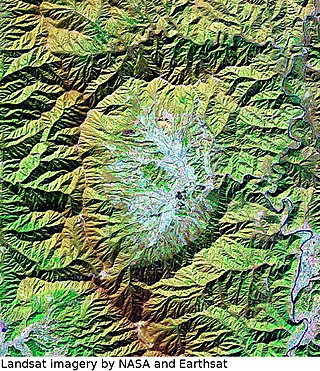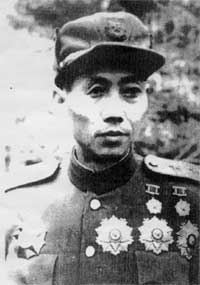
The Korean War was fought between North Korea and South Korea from 1950 to 1953. The war began on 25 June 1950 when North Korea invaded South Korea. The war ceased with an armistice on 27 July 1953. North Korea was supported by China and the Soviet Union while South Korea was supported by the United States and the United Nations (UN).

The Korean People's Army is the military force of North Korea and the armed wing of the Workers' Party of Korea (WPK). The KPA consists of five branches: the Ground Force, the Naval Force, the Air Force, Strategic Force, and the Special Operation Force. It is commanded by the WPK Central Military Commission, which is chaired by the WPK general secretary, and the president of the State Affairs; both posts are currently headed by Kim Jong Un.
This is the Korean War order of battle. Subsidiary commands are listed on sub-pages. Where no date is shown for a command, assume it present at the start of the war, on June 25, 1950.

Chŏngjin is the capital of North Korea's North Hamgyong Province (함경북도) and the country's third-largest city. It is sometimes called The City of Iron.
The Battle of the Twin Tunnels took place during the Korean War. In which the UN forces inflicted heavy casualties on the People's Volunteer Army (PVA). The "Twin Tunnels" refer to a series of railroad tunnels along the Central Line in eastern Jije-myeon, Yangpyeong County, Gyeonggi Province, South Korea.

The Korean People's Army Ground Force is the main branch of the Korean People's Army, responsible for land-based military operations.
The Battle of Yultong, also known as the Battle of Puluodong, Battle of Yuldong, or Battle of Yuldong-ri, took place during the Korean War. It was fought between elements of the Chinese People's Volunteer Army (PVA) 34th Division and the Filipino 10th Battalion Combat Team (BCT), north of Yeoncheon during April 22–23, 1951. The battle was part of the Chinese Spring Offensive.
The 89th Division(Chinese: 第89师)(2nd formation) was a military formation of the People's Liberation Army.
The 59th Division was a military formation of the People's Liberation Army, which was created in February 1949 under the Regulation of the Redesignations of All Organizations and Units of the Army, issued by the Central Military Commission on November 1, 1948, basing on the 2nd Division, 1st Column of Huadonng Field Army. Its origin can be traced back to the Jiangnan anti-Japanese volunteers' Army(lang-zh:江南抗日义勇军) formed in May 1939. Under the command of PLA 20th Corps it took part in the Chinese civil war.
The Inner Changshan Fort District, formerly known as the 78th Division, is a military formation in the People's Liberation Army of China. It is currently a coastal defense formation of the Jinan Military Region.
The Battle of Chuam-ni was fought between 14–17 February 1951, at Chuam-ni, South Korea, as part of the Chinese People's Volunteer Army (PVA) Third Offensive towards Wonju during the Korean War. The battle was for control of the supply line Route 24.

The Battle of Wawon(Korean: 군우리 전투; hanja: 軍隅里戰鬪; rr: Gunuri Jeontu; Turkish: Kunu-ri Muharebesi), also known as the Battle of Wayuan, was a series of delay actions of the Korean War that took place from 27–29 November 1950 near Wawon in present-day North Korea. After the collapse of the US Eighth Army's right flank during the Battle of the Ch'ongch'on River, the Chinese People's Volunteer Army (PVA) 38th Corps advanced rapidly towards the critical road junction at Kunu-ri in an effort to cut off United Nations forces' retreat route. In what was considered to be Turkey's first real combat action since the aftermath of World War I, the Turkish Brigade attempted to delay the Chinese advances at Wawon. Although during the battle the Turkish Brigade was crippled after being encircled by Chinese forces with superior numbers, they were still able to breach the Chinese trap and rejoin the US 2nd Infantry Division. Delay of the PVA advance after meeting with heavy Turkish resistance helped the other United Nations forces to withdraw without suffering many casualties and reassemble later in December.

The Third Battle of Seoul was a battle of the Korean War, which took place from December 31, 1950, to January 7, 1951, around the South Korean capital of Seoul. It is also known as the Chinese New Year's Offensive, the January–Fourth Retreat or the Third Phase Campaign Western Sector.

The First and Second Battles of Wonju, also known as the Wonju Campaign or the Third Phase Campaign Eastern Sector, was a series of engagements between North Korean and United Nations (UN) forces during the Korean War. The battle took place from December 31, 1950, to January 20, 1951, around the South Korean town of Wonju. In coordination with the Chinese capture of Seoul on the western front, the North Korean Korean People's Army (KPA) attempted to capture Wonju in an effort to destabilize the UN defenses along the central and the eastern fronts.

The 58th Medium Combined Arms Brigade is a brigade of the People's Liberation Army Ground Force. It is one of the six combined arms brigades of the 83rd Group Army under the Central Theater Command. The 58th was previously a division, being converted to a brigade-sized formation in 1998.

The Punchbowl was the name given to the bowl-shaped Haean Basin (해안분지) in Yanggu County, Gangwon Province by UN Forces during the Korean War. The Punchbowl lies several km south of the Korean Demilitarized Zone.

This is a list of military parades held in Pyongyang, the capital of the Democratic People's Republic of Korea (DPRK) since 1948. All military parades consist of troops from the Korean People's Army and the paramilitary Worker-Peasant Red Guards. All military parades of a national nature are held on Pyongyang's Kim Il-sung Square with the General Secretary of the Workers' Party of Korea, President of the State Affairs Commission and Commander-in-Chief of the Armed Forces of North Korea in attendance. These parades are broadcast live on Korean Central Television.

Ri Tu-ik was a North Korean politician of the Workers' Party of Korea and Vice-Marshal of the Korean People's Army, who was a member of the Central Military Commission of the Workers' Party of Korea.

Pang Ho-san was a communist anti-Japanese activist and general of the Democratic People's Republic of Korea.

O Paek-ryong was a North Korean politician and general.












